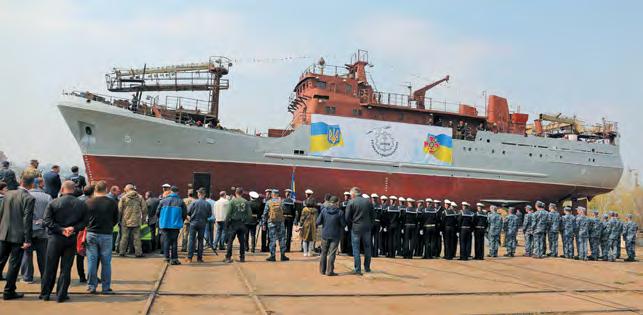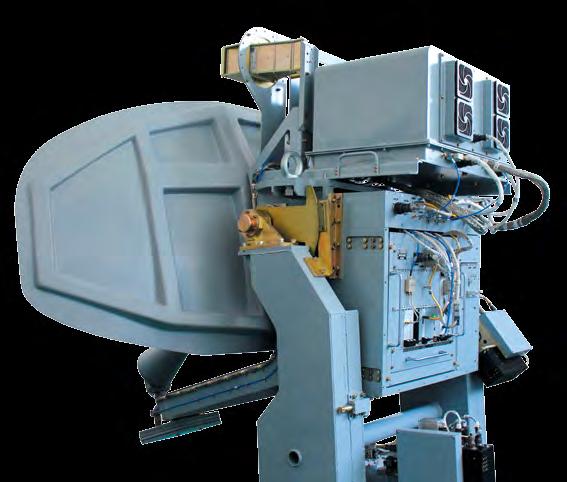
7 minute read
reconnaissance
Nava SIGINT Ca abilit y for Ukr ain e Sy te that ne y will ever be ble to Spot
Melkhior (Ukrainian for "German silver"). This is the name chosen for a new shipboard Signals Intelligence (SIGINT) system developed by the Quant-Radiolocation R&D Institute for Radar Systems.
Advertisement

The Melkhior is going to become the hallmark of and a key competitive advantage for the SIGINT ship being built for the Ukrainian Navy, under the Government Defense Procurement Contract, at Kuznya na Rybalskomu Shipyard, Kyiv. The naval SIGINT system Melkhior has already gone through factory-level tests and is now being prepared to enter official qualification trials process onboard the ship once she is finished.
Innov ativ e Developm ent The development of passive radar location systems in Ukraine has until recently been Identified with the renowned system Kolchuga. After Rus-
sia’s seizure and de-facto liquidation of the Topaz Factory in Donetsk, the production of Kolchuga systems in Ukraine was discontinued and never resumed. But now Ukraine has something with which to plug a gap in the development of modern SIGINT capabilities.
Quant-Radiolocation, an affiliate of the Ukroboronprom State Defense Industries Group, has developed its Melkhior system that uses a passive radio location technique focusing on radiofrequency analysis of reflected signals for "fingerprinting" transmitters or operators.
Quant-Radiolocation is confident about the potential and capabilities of its developed system Melkhior, describing it as "representing newgen, world-class technology in this domain, which compares with top of the line brands such as Thales." The French firm is mentioned here for good reason. A Thales’ SIGINT system was among those considered for this Ukrainian project, but the Ukrainian Navy’s top brass decided to choose in favor of own domestic capabilities, and this decision seems to have been right.
The Melkhior can operate over ranges up to 450 km, which is a lot farther than the radio horizon range. This is achieved due to the use of the effect of super-refraction – the bending of the radar beam in passing through layers of air of varying density. The effect of super-refraction is to increase the bending of the radar wave and thus increase the range from which echoes may be returned. The knowledge of the laws of physics, integrated into state-of-the-art technologies produces a capability to detect adversary radars at substantially longer ranges.
In addition to boasting its impressive range performance, the Melkhior can track up to 200 targets simultaneously, ten times as many as the Kolchuga can. Moreover, while the Kolchuga is effective against primarily aerial targets, the Melkhior can track targets over sea surface and in the air, as well as targets ashore. By fusion of data from Melkhior and other multiple sensors it’s possible to evaluate true capabilities of the opposing forces and to keep track of enemy movements and activities in real time. But there is more.

From Edg e to Edg e Another advantage that can be achieved with the Melkhior lies in its wide Seamless frequency range covering 1 to 18 GHz. This frequency range was chosen because many of modern airborne radars typically operate at frequencies of 12 to 18 GHz. "We were the first to provide full coverage of that wide frequency range without gaps in frequency coverage. Seamlessness dispenses the need for fine-tuning the system for a given sub-band of frequencies as was the case with the Kolchuga," the Melkhior Developer says.
The Melkhior System is composed of an antenna post and two operator workstations. The System has been developed with a maximum possible automation level of processes relating to search, detection and identification of radio transmission sources. It is designed with capabilities to: locate the
position of transmitters, analyze and classify reflected signals, and record those unique signal profiles in relevant data libraries. The System would certainly come pre-loaded with an "a-priory library" encompassing data on a majority of targets that may be most commonly encountered in the Black Sea Theater of operations. But everything is changing and so must the Melkhior’s library of targets.
A monitoring operator can hold, for as long as necessary, on any of the 200 targets that are within the radar’s field of view and visualized on his display. The data recorded for each target, or, more specifically, transmitter includes transmission power, pulse duration and repetition rate, and transmission frequency range. All relevant detailed data is then automatically forwarded to on-line database. Data collection is conducted with the other workstation that hosts a high-capacity data storage device. Data from the on-line database can be shared to other SIGINT sensors.
The Melkhior has its "brains" built into silver-colored boxes measuring 150x100 mm that comprise part of the antenna post. These can be easily swapped in and out as needed. →
This is about not just the ease of maintainability but the implementation of an open architecture that makes it easy to upgrade or swap components without the need for redesigning the other units or an entire system.
Miniaturization of the System’s "brains" and concurrent improvements in the power and quality of processing input signals from the wideband receiver have come about through the use of foreign-brand electronic and hardware components (specific brands would be selected based on Customer needs and preferences).
The hardware is important indeed, but the software is the brain that runs it. It is, therefore, precisely the signal processing algorithms which, along with the knowledge of their logic and operation, make up the hallmark of this Quant-Radiolocation’s development, making it truly competitive against counterparts developed by foreign, high-value companies with multi-billion revenues.
"Our serious achievement is the development of software. We have known how to identify frequency ranges, and we can draw waveforms of signals. An incoming signal is processed while it is already in the front UHF channel. To do this requires high-performance integrated circuits. We are using top of the line processors from the U.S. manufacturer Virtex. The use of a highly sensitive wideband signal receiver and of our developed algorithms has made it possible to achieve substantial increases in the System’s productivity and operational robustness and reliability compared to its previous iterations," the author was told at the Company.
In Searc h of Innov ativ e Solution s The antenna post integrates a reflector antenna with a wideband signal receiver, signal processing units and antenna stabilization system. "The antennas that we used in all our previous projects had their curtains made from aluminum alloys. In developing this new system, however, we were confronted with the fact that the quality of aluminum available in the market doesn’t allow us to produce a curtain with the required performance, with all the implications for the performance of the system as a whole. Accuracy requirements are quite high, with the mean-square error on the reflector’s surface not exceeding 0.2 mm," the Developer has explained. This is where new technologies came in hand, again. The antenna for the Melkhior was for the first time made from composite materials. The ductility of carbon fiber allows to customize the configuration, dimensions and sphericity of the antenna curtain, in addition to strength and robustness. Moreover, there had been worked out a new process for embedding a metal grid into the carbon fiber structure. It is this metal grid that reflects the RF waves.
For protection against the weather, dust, salt water, foreign matter, etc the rotating antenna assembly is mounted inside a composite-material dome that is transparent to radio-frequencies. The protective dome and the carbon-fiber antenna have both been produced by a privately-run firm based in Mykolayiv. The antenna post comes with a stabilizer system to ensure stabilization against motions of the carrying platform at sea. Interfaced with the ship’s navigation suite, the stabilizer measures the angle relative to the horizon and azimuth of the antenna at which the antenna should be rotated so that its radiation pattern remains stable, whatever the roll and pitch angles of the carrier ship.
From Sea to Ground But the Melkhior may find its utility also in domains other than the maritime domain. Weighing approximately 900 kg with full complement of equipment (the antenna post plus two operator workstations), it well fits into a KRAZ 6x6 truck bed to provide a mobile ground SIGINT capability that would be able to detect and identify targets while remaining stealth to enemy radars. A capability like that is sought after on markets in Ukraine and elsewhere.
Quant-Radiolocation is now poised to develop a configuration that would be tailored for installation on ground platforms, fixed as well as mobile. There is an expectation that the Melkhior, in its ground vehicle-based configuration will be ready for display at the Arms & Security Expo next year.

Serhiy ZGHURETS, Defense Express











